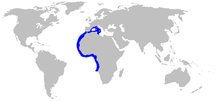Sawback angel shark
| Sawback angel shark | ||||||||||||
|---|---|---|---|---|---|---|---|---|---|---|---|---|
| Systematics | ||||||||||||
|
||||||||||||
| Scientific name | ||||||||||||
| Squatina aculeata | ||||||||||||
| Cuvier , 1829 |
The sawback angel shark ( Squatina aculeata ) is an angel shark up to 188 centimeters long . It occurs in the coastal area of West and North Africa and in the western Mediterranean.
Appearance and characteristics
The sawback angel shark can reach a maximum body length of about 188 cm. As with other angel sharks, the body is strongly flattened with very broad pectoral fins , which makes them look more like long rays in shape . However, the pectoral fins are clearly separated from the trunk, while in most rays they merge seamlessly into the body. They have two dorsal fins and no anal fin . The body has a dark gray to light brown back color, which is marked with small, irregular white and more regular dark brown spots. There are also large dark spots on the head, the back, the base of the fins and the tail. On the head there are large thorns concave from the eyes over the mouth, which are also present on the midline of the back.
The eyes are on the top of the head, the mouth is terminal, the outer nostrils are provided with short barbels . The injection holes are large, the number of gill openings at the bottom is five. The distance between the eyes and the spray hole in this type is approximately 1.5 times the diameter of the eye. In addition, the species has strongly fringed barbels and nose flaps.
distribution
The distribution area of the sawback angel shark is in the coastal area of West and North Africa as well as the western Mediterranean . In the south it extends to Nigeria , Gabon and Namibia .
It lives on the outer edge of the continental shelf at depths between 30 and 500 meters, where it occurs mainly on muddy subsoil.
Way of life
Little data is available on the biology of this shark. He feeds mainly on small sharks and bony fish, cephalopods and crabs . Like all angel sharks, it is ovoviviparous - the eggs are hatched in the mother before the young are born alive. The animals reach sexual maturity with a body length of about 124 centimeters.
Relationship to humans and danger
The International Union for Conservation of Nature (IUCN) classifies this shark as critically endangered.
Like the smooth angel shark ( S. oculate ) that occurs in the same habitat , this species was once very common. Above all, it is endangered by the intensive fishing of the coastal areas and continental shelves through bottom and drift nets and bottom lines, which affects most of its range off the African coast. The sharks are caught as bycatch , as a result of which the population has plummeted over the past 50 years; the species has apparently disappeared in large areas of the northern Mediterranean and African coastal waters. Together with the two related species Squatina oculata and Squatina squatina , the Portuguese fisheries authorities recorded a decline of 95% between 1990 and 1998 in the area off Morocco and Mauritania . The fishing pressure is correspondingly very high and is likely to increase in the future.
supporting documents
- ↑ a b Squatina aculeata in the Red List of Endangered Species of the IUCN 2010. Listed by: Morey, G., Serena, F., Mancusi, C., Coelho, R., Seisay, M., Litvinov, F. & Dulvy, N., 2007. Retrieved December 17, 2010.
literature
- Leonard Compagno , Marc Dando, Sarah Fowler: Sharks of the World . Princeton University Press , Princeton and Oxford 2005, ISBN 978-0-691-12072-0 , pp. 137-138.
